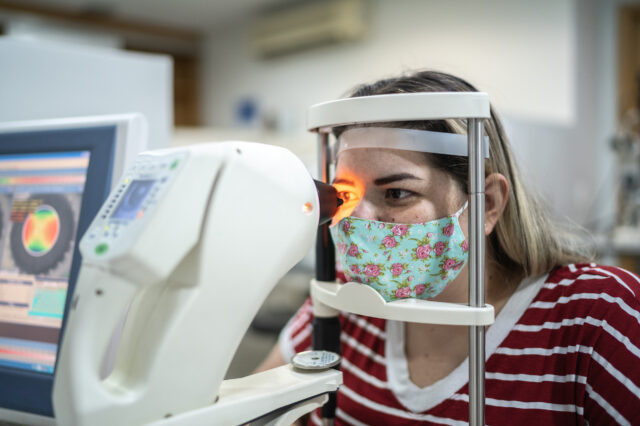Could my blurry vision be cataracts?
People with a cataract in one or both eyes experience blurry vision from the clouding of the eye’s natural lens

Update your location to show providers, locations, and services closest to you.
Glaucoma is a disease of the optic nerve, the part of the eye that carries images we see to the brain.
The front of the eye is filled with a fluid, called aqueous humor. This fluid is mostly water, and the main purpose is to inflate and maintain the shape of the eye. This fluid is very similar to water in a balloon, and sometimes the eye pressure can be too high. In such cases, pressure is placed on the optic nerve. This elevated pressure causes damage to the optic nerve. If the optic nerve is damaged, then vision cannot be transmitted from the eye to the brain, resulting in blindness. Unfortunately, damage to the optic nerve is not typically reversible. Once vision is lost, it cannot be restored. Therefore, screening and prevention are the keys to good glaucoma care. If detected, glaucoma is often treated with topical medications (eye drops), laser treatments or surgery.
There are many forms of glaucoma, but the hallmarks of all forms of glaucoma are damage to the optic nerve and visual field loss. New risk factors for glaucoma are always being discovered, but elevated intraocular pressure, increasing age, African-Americans and a family history of glaucoma remain among the highest risk factors.
Common types of glaucoma include:
Screening for glaucoma can be done during a routine eye exam. The intraocular pressure is measured and a slit-lamp exam is performed, which is a microscopic exam of the anterior aspect of the eye. In addition, the optic nerve is examined for any evidence of abnormalities (cupping).
If the examination is suspicious for glaucoma, more specific studies can be done. These include visual field testing, optic nerve photography, and OCT (optical coherence tomography). These studies may not only help make the diagnosis of glaucoma, but help establish a baseline. Glaucoma in its most common form is a slowly progressive disease. Therefore, establishing a baseline helps assess the rate of disease progression and aid in the selection of treatment options.
Typically, for the most common form of glaucoma (open angle glaucoma), treatment options will include medications, laser treatments or eye surgery. Frequently, a combination of these options may be used. The goal of glaucoma treatment is to decrease intraocular pressure and prevent damage to the optic nerve. At the beginning of treatment, the doctor will generally recommend medication or a combination of eye drops and oral medications for the specific condition.
Laser treatment can open the drainage angle and reduce intraocular pressure. Although traditional surgery can be done to create a new passage for fluid drainage, it is usually reserved for cases that cannot be controlled by medication or if laser treatment was not successful.
Glaucoma is a chronic condition that is not "cured" by the treatment; it requires continued monitoring. When deciding on which treatment options, it is necessary for the physician and patient to thoroughly discuss the risks and benefits.
Several different classes of glaucoma medications are available, including beta blockers, prostaglandin analogues, alpha adrenergic agonists, miotic, epinephrine compounds and oral and topical carbonic anhydrase inhibitors. These medications work by either reducing the rate at which fluid in the eye is produced or increasing the outflow of fluid from the eye.
Laser surgery has become increasingly popular as an intermediate step between drugs and traditional surgery. The most common type performed for open-angle glaucoma is called trabeculoplasty. This procedure takes 10 to 20 minutes, is painless and can be performed in either a doctor's office or outpatient facility.
The most common form of traditional surgery is called a trabeculectomy. In this procedure, the surgeon removes a small section of the trabecular meshwork to allow the aqueous humor to drain more easily, reducing pressure in the eye. This procedure is usually done under local anesthesia, either as an outpatient or with a brief hospital stay since your doctor will want to see you the day after surgery. It is important to note that your eyes may not have their normal visual acuity for several weeks following this procedure. Although trabeculectomy is a relatively safe surgical procedure, about one-third of patients develop cataracts within five years of surgery. After trabeculectomy, most patients are able to discontinue all anti-glaucoma medications. Ten to 15 percent of patients require additional surgery.
Minimally invasive glaucoma surgery is associated with much fewer side effects and complications and faster recovery, but the pressure-lowering effect is less than that of traditional glaucoma surgery. These less invasive surgeries may be appropriate for you if you have mild or moderate vision loss from glaucoma. Minimally invasive glaucoma surgery is frequently done in conjunction with cataract surgery.
In most cases, glaucoma has no symptoms. By the time an individual experiences decreased vision, the disease is frequently in its later stages.
The symptoms depend on the type of glaucoma the individual has. Those who have chronic glaucoma may not be aware of any symptoms because the disease develops slowly and patients rarely notice loss of peripheral vision. Those who have an acute form of glaucoma may develop severe symptoms because ocular pressure rises quickly. They may experience blurred vision, especially at night, halos or rainbows around lights, severe headaches or eye pain and nausea.
Since early warning signs of glaucoma are rare, it is important to have regular medical eye exams especially for those at risk.
Patients who may be at risk for glaucoma include:
Regular diagnostic examinations by an ophthalmologist are important in preventing loss of vision. Although there is no way to reverse damage, if glaucoma is diagnosed and treated early, blindness almost always is preventable.
Quality of life is an important factor in the treatment of any chronic ailment. It is important to make a decision as to whether you want to live with significant side effects. You should first consider whether there is a way to eliminate the side effects of the medications you are taking. Talking with your ophthalmologist is the best approach to identifying possible ways to resolve the problem of medication side effects.
If you are still suffering from intolerable side effects, or if your glaucoma is uncontrolled, then surgery may be an option.
Glaucoma surgery is safer and more effective than ever. Surgery for uncomplicated open-angle glaucoma, when performed as an initial surgical procedure in a patient who has not had previous intraocular surgery, is highly effective. The chance of complications or surgical failure increases with previous intraocular surgery, complicated glaucoma, having to redo the operation for glaucoma and severe nearsightedness.
Generally, the answer is no. In some forms of glaucoma, the pressure may become extremely elevated (above 40 mm high). In such cases the patient may experience pain, blurry vision, halos, or nausea and vomiting.

People with a cataract in one or both eyes experience blurry vision from the clouding of the eye’s natural lens

We continue our celebration of Asian American and Pacific Islander, or AAPI, Heritage Month, by featuring Darrell WuDunn, MD.
